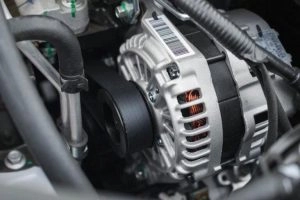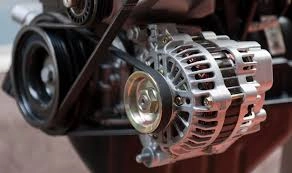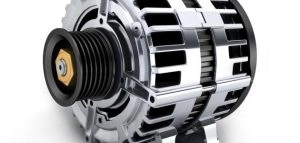The car is considered a necessary tool in our daily life, as it allows us to move around and reach the place we want easily and conveniently. However, to ensure the car operates effectively and properly, we must understand every part of it and its function. One of these important parts is the car's alternator, which we will discuss.
In this article, we will define it, discuss its function and importance, and outline the necessary steps for its inspection.

What is the car's dynamo?
The car's alternator is a vital component in the vehicle's charging system, and is considered the source of the electric power needed to operate the car. The alternator consists of several parts, which include:
1- Rotor: It is the rotating part that moves within the coils, converting mechanical motion into electrical energy.
2- The Stator: These are the electrical coils found inside the dynamo, through which the rotor is passed to convert mechanical motion into electrical energy.
3- Mounting location: This is the part where the car's dynamo is installed on the engine, and it is connected to the relay, the brush, and the battery.
4- Carbon Brushes: These are the components found in the contact section, and are used to transfer the electrical current from the stage toThe BatteryApologies, but the text box seems to be empty. Could you please provide me with a specific text for translation?
5- Diodes: This is an important part found in the alternator, used to enhance its performance and protect it from excessive heat.
6- The Regulator: It is the part responsible for controlling the electric current being sent to the battery, and it works on determining the appropriate current level for charging the battery.
The function of the car's dynamo
The dynamo works by converting the mechanical energy generated from the engine movement into electrical energy, where it generates an electric current that is sent to the battery to recharge it and store the necessary energy to operate the car.
It also provides the necessary energy to operate many electrical systems in the car such as:
Lighting System:
The lighting in the front and rear lamps, and the indicators.
2- Audio System:
The radio, speakers, and recorders
Also read: Dynamo Cutout 5 Symptoms Indicating its Damage

What is the importance of a car's dynamo?
The car's dynamo is a crucial part of the charging system, responsible for supplying the car with the necessary electrical energy to operate the lighting, sound, safety, computer systems and many other accessories that require electrical current to function. If the dynamo fails, it may lead to a drained battery and halt all the car's electrical systems, resulting in the car's inability to operate.
It seems like there's no text provided. Could you please provide the text you want translated?What are the reasons for the damage to the car's dynamo?
There are many things that can cause damage to a car's alternator:
1- Excessive use or extreme wear over time.
2- High electrical loads or continuous use of power-hungry devices can strain the alternator.
3- An aged or damaged serpentine belt can cause weak charging and make the alternator work harder than it should.
4- Excessive temperatures under the hood or overheating of the alternator can cause damage to its internal components.
5- The entry of water or moisture inside the generator can cause an electrical failure and damage the generator.
6- Overcharging or undercharging of the battery due to a malfunctioning voltage regulator.
Regular maintenance and inspection by a qualified mechanic can help prevent damage to the alternator and ensure optimal performance.
What are the important steps to check the car's alternator?
Checking the alternator is an important task that should be done regularly to maintain the health and performance of the car. Here are the steps to check the alternator:
1- Ensuring the car is running: The engine must be running to check the alternator, this is because the alternator converts mechanical motion into electrical energy.
2- Measuring Voltage: You should use a voltmeter to measure the voltage generated by the dynamo. The voltage should be between approximately 13 and 14 volts when the engine is running.
3- Brush Inspection: It is crucial to check the condition of the brush and ensure that it is not damaged. Additionally, the connection between the brush and the commutator must also be verified to be intact.
4- Checking the electronic regulator: The electronic regulator must be checked to ensure it is damage-free. An electronic inspection device can be used for this purpose.
5- Check the heat shield: The heat shield should be inspected to ensure its integrity and that there's no damage. It is also necessary to make sure it is functioning correctly to protect the alternator from excessive heat.
6- Rotor Inspection: The rotor should be inspected to ensure its integrity and the absence of damage. It is necessary to confirm that it rotates correctly within the stage.
7- Inspect the connectors and cables: Make sure that all the connectors and cables connected to the alternator are intact and free from damage or harm.
8- Checking the electric current: The electric current that comes from the alternator should be measured using an ammeter. The current should be within the range specified in the car user manual.
9- Electrical tension inspection: The electrical tension output from the alternator must be measured using an electrical tension meter. The tension should be within the range specified in the car's user manual.
10- Electronic Regulator Check: It is essential to inspect the electronic regulator that controls the distribution of the electric current coming out of the car's alternator. It must be ensured that it is functioning correctly and distributing the current in the right manner.
11- Check the conveyor belt: Ensure that the connected conveyor belt is intact and does not have any damage or cracks.
12- Check the electrical wires: It is necessary to ensure the integrity of the electrical wires connected between the car's alternator and the battery, and between the other parts in the car.
13- Check the brake pads: In case they wereThe car's dynamoIt operates on brake pads, they should be inspected and ensured that they are working properly and do not need to be replaced.

The Conclusion
In conclusion, it can be said that the car's alternator is a crucial part of the charging system, which plays a significant role in generating the necessary electrical power to operate many of the car's electrical systems.
To maintain its good performance, we must pay attention to its maintenance and carry out regular checks on it, and not ignore it in case there are any signs of a problem with it.

Comments